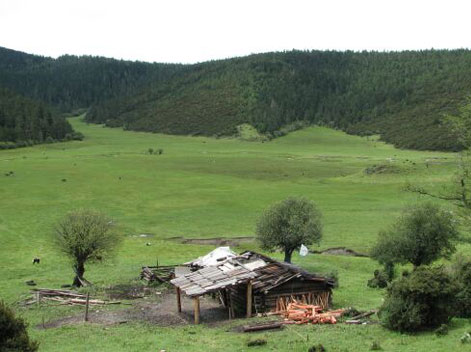
Diqing lies in the northwest corner of Yunnan province, in a geographic region where the Himalayan Mountains are slowly merged with the not so high peaks of the Hengduan Range. In the border with the Tibet Autonomous Region and Ganzi Tibetan Autonomous Prefecture, it shares with them an environment essentially Tibetan, but with important regional characteristics.
Diqing Tibetan Autonomous Prefecture has an area of 23,870 square kilometers and a registered population (in 1998) of 353,272 inhabitants.
Diqing Tibetan Autonomous Prefecture is a neatly Tibetan area. Everywhere in the core area of this prefecture Tibetan people and Tibetan villages are found, but far from being a homogenously ethnic prefecture, a rugged landscape has become the home of some other national minorities. Near the Mekong River there are also important Lisu populations, in fact, Weixi County, where they live, has been declared a Lisu Autonomous County. In the vicinity of Lijiang Region there are living some Naxi people, especially in Sanda Township, where the beautiful landscape of Baishuitai can be found, and where is said that the Dongba traditions are preserved in all its purity. This is because according to their tradition, Dingba shilo, the founder of the Dongba religion, spent some years meditating in a nearby cave, and all the aspirants to become Dongba priests must come through a kind of initiation ceremony in this cave. In the mountains that separate the Naxi from the Tibetan there are many Yi villages, most of them inhabited by the Nuosu branch of the Liangshan prefecture in Sichuan Province. These Nouso are a recently arrived people to Diqing, with a presence that can not be extended more than one or two hundred years. Also recently arrived are the Miao people that inhabit some of the poorest and less accessible lands.
The minorities that inhabit Diqing, according to the 2000 census, are shown below:
Tibetan, 117,000, are 33,8% of Diqing population.
Lisu, 98,000. 27%
Han, 57,000. 16%
Naxi, 45,000. 13%
Bai, 18,000. 5,1 %
Yi, 11,500. 3,3%
Hui, 1,500.
Pumi, 1.500
Miao, 1,400..
And there are also even smaller populations of Nuzu and Dulong.
Diqing Prefecture has three lower level administrative units:
- Shangrila County (formerly known as Zhongdian County). With an extension of 11,613 square kilometers and a registered population of 130.000.
- Deqin County. With an area of 7,596 and a registered population of about 60.000.
- Weixi Lisu Autonomous County. With an area of 4,661 and a registered population of 140.000.
Most of the surface of Diqing prefecture is covered by forest. It has some of the most beautiful national parks of China, as Pudacuo National Park, near Shangrila, established around the Bita Lake. Other interesting natural landscapes are found in The Tiger Leaping Gorge, The Baishuitai Terraces, the Baima Snow Mountain, and especially the Kawarkapo, one of the sacred mountains to the Tibetan people, in the northwest corner of this prefecture.
The religious center of this prefecture is Songzanlin Monastery, of the Tibetan Yellow Sect, in the outskirts of Shangrila.
We recommend:
